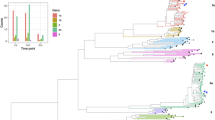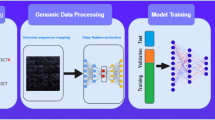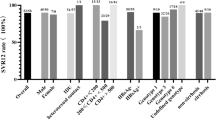Abstract
A novel class of geldanamycin (GA) derivatives as hepatitis C virus (HCV) replication inhibitors has been synthesized and their anti-HCV activities were evaluated in GS4.3 HCV replicon cells. Most of the synthesized compounds demonstrated potential activities against HCV in vitro. Substitution with an aliphatic cyclic group (2b) and polar phosphate group (2f) at the 17 position of GA resulted in more potent inhibitory activity. The configurations of the tetrahydrofurfurylamino (THFM) substituents obviously affected their antiviral activities. The 2b with a 2′-(R)-THFM group at the 17 position showed much potent activity and higher selectivity than its 2′-(S) and 2′-(R, S) epimers. In the tested GA derivatives, 2b and 2f show the most potential leading compounds for development of novel anti-HCV agents.
Similar content being viewed by others
Log in or create a free account to read this content
Gain free access to this article, as well as selected content from this journal and more on nature.com
or
References
Koziel, M. J. & Peters, M. G. Viral hepatitis in HIV infection. N. Engl. J. Med. 356, 1445–1454 (2007).
Zeuzem, S. Interferon-based therapy for chronic hepatitis C: current and future perspectives. Nat Clin Pract Gastroenterol Hepatol. 5, 610–622 (2008).
Moriishi, K. & Matsuura, Y. Evaluation systems for anti-HCV drugs. Adv. Drug Deliv. Rev. 59, 1213–1221 (2007).
Pawlotsky, J. M., Chevaliez, S. & McHutchison, J. G. The hepatitis C virus life cycle as a target for new antiviral therapies. Gastroenterology. 132, 1979–1998 (2007).
Kronenberger, B., Welsch, C., Forestier, N. & Zeuzem, S. Novel hepatitis C drugs in current trials. Clin Liver Dis. 12, 529–555 (2008).
Soriano, V., Peters, M. G. & Zeuzem, S. New therapies for hepatitis C virus infection. Clin. Infect. Dis. 48, 313–320 (2009).
Klebl, B. M., Kurtenbach, A., Salassidis, K., Daub, H. & Herget, T. Host cell targets in HCV therapy: novel strategy or proven practice? Antivir. Chem. Chemother. 16, 69–90 (2005).
Tai, A. W. et al. A functional genomic screen identifies cellular cofactors of hepatitis C virus replication. Cell Host Microbe. 5, 298–307 (2009).
Moriishi, K. & Matsuura, Y. Host factors involved in the replication of hepatitis C virus. Rev. Med. Virol. 17, 343–354 (2007).
Okamoto, T. et al. Hepatitis C virus RNA replication is regulated by FKBP8 and Hsp90. Eur. Mol. Biol. Organ. 25, 5015–5025 (2006).
Nakagawa, S. I. et al. Hsp90 inhibitors suppress HCV replication in replicon cells and humanized liver mice. Biochem. Biophys. Res. Commun. 353, 882–888 (2007).
Schnur, R. C. et al. Inhibition of the oncogene product p185erbB−2in vitro and in vivo by geldanamycin and dihydrogeldanamycin derivatives. J. Med. Chem. 38, 3806–3812 (1995).
Lanford, R. E. et al. Antiviral effect and virus-host interactions in response to alpha interferon, gamma interferon, poly(I)-poly(C), tumor necrosis factor alpha, and ribavirin in hepatitis C virus subgenomic replicons. J. Virol. 77, 1092–1104 (2003).
Liu, W. L. et al. Ribavirin up-regulates the activity of double-stranded RNA-activated protein kinase and enhances the action of interferon-α against hepatitis C virus. J. Infect. Dis. 196, 425–434 (2007).
Lohmann, V. et al. Replication of subgenomic hepatitis C virus RNAs in a hepatoma cell line. Science. 285, 110–113 (1999).
Yang, J. H. et al. Real-time RT-PCR for quantitation of hepatitis C virus RNA. J. Virol. Methods. 102, 119–128 (2002).
Acknowledgements
This work was supported by the National Nature Science Foundation of China (Grant 30472076), ‘863’ program from the Ministry of Science and Technology of China (2006AA028414) and the National Major Science and Technology Project of China (‘Innovation and Development of New Drugs’, 2009ZX09301-003).
Author information
Authors and Affiliations
Corresponding authors
Rights and permissions
About this article
Cite this article
Shan, Gz., Peng, Zg., Li, Yh. et al. A novel class of geldanamycin derivatives as HCV replication inhibitors targeting on Hsp90: synthesis, structure–activity relationships and anti-HCV activity in GS4.3 replicon cells. J Antibiot 64, 177–182 (2011). https://doi.org/10.1038/ja.2010.161
Received:
Revised:
Accepted:
Published:
Issue date:
DOI: https://doi.org/10.1038/ja.2010.161
Keywords
This article is cited by
-
Synthesis and biological evaluation of geldanamycin analogs against human cancer cells
Cancer Chemotherapy and Pharmacology (2015)
-
Geldanamycin, a ligand of heat shock protein 90, inhibits herpes simplex virus type 2 replication both in vitro and in vivo
The Journal of Antibiotics (2012)
-
Antiviral drugs against hepatitis C virus
Genetic Vaccines and Therapy (2011)



